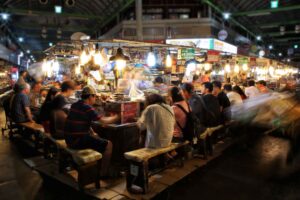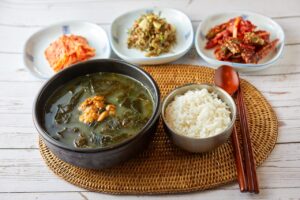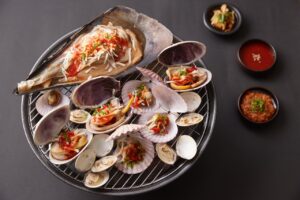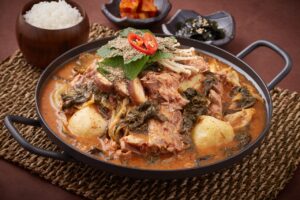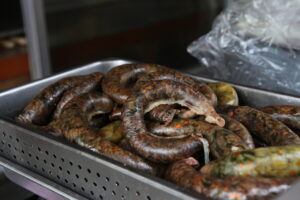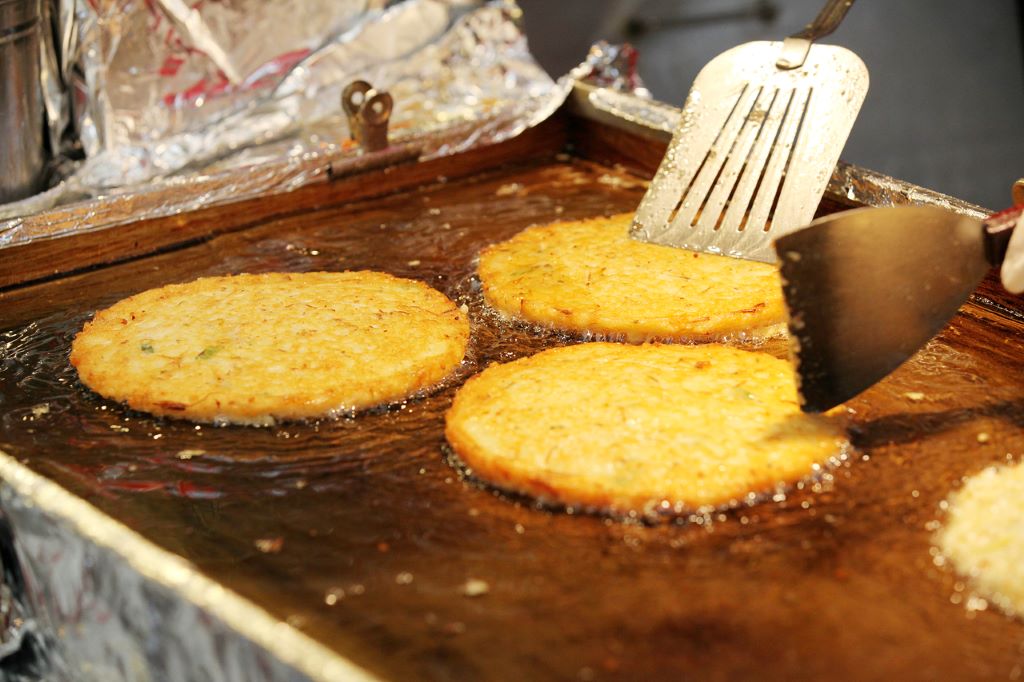
bindaetteok1 - ⓒ한국관광공사 사진갤러리-한국관광공사 박은경
What is Bindaetteok?
“Bindaetteok” (빈대떡) is a popular Korean savory pancake made from mung beans. It’s also known as “mung bean pancake” or “mung bean sprout pancake.” It is a beloved street food and snack in Korea, enjoyed for its crispy texture, rich flavor, and the combination of ingredients that go into its batter.
Key Features of Bindaetteok:
- Mung Bean Base: It is primarily made from ground mung beans, which are soaked, ground into a batter, and then mixed with various ingredients.
- Ingredients: The batter of bindaetteok typically includes mung beans, mung bean sprouts, green onions, kimchi, and sometimes minced pork or seafood. These ingredients add flavor, texture, and color to the pancake.
- Crispy Exterior: When cooked, bindaetteok develops a crispy and golden-brown exterior, while the interior remains soft and flavorful.
- Dipping Sauce: It is often served with a dipping sauce made from soy sauce, vinegar, and other seasonings. The sauce complements the pancake’s flavors.

Bindaetteok recipe
- Soak Mung Beans: Mung beans are soaked in water for a few hours or overnight to soften them.
- Grind Mung Beans: The soaked mung beans are ground into a coarse batter. Some variations include adding a bit of water to achieve the right consistency.
- Mix Ingredients: Chopped mung bean sprouts, green onions, kimchi, and any other desired ingredients are mixed into the batter.
- Cook Pancakes: The batter is spooned onto a hot oiled griddle or pan, forming individual pancakes. The pancakes are flattened slightly with a spatula.
- Fry Until Crispy: The bindaetteok is cooked over medium heat until the bottom is golden and crispy. It’s then flipped to cook the other side until crispy as well.
- Serve: It is cut into wedges and served with a dipping sauce, often made from soy sauce, vinegar, sesame oil, and possibly other seasonings.
Variations:
- Yachae Bindaetteok: This is a vegetarian version of bindaetteok that omits the meat and seafood, making it suitable for vegetarians.
- Nokdu Bindaetteok: “Nokdu” means mung beans in Korean, so this variation simply refers to the classic mung bean pancake.
- Seafood Bindaetteok: Some versions of bindaetteok include seafood, such as shrimp or squid, in addition to mung bean sprouts and other ingredients.
It is often enjoyed as a snack, appetizer, or side dish in Korean cuisine. Its unique combination of ingredients and textures, along with its satisfying crunch, make it a popular choice among locals and visitors alike.
History of Bindaetteok
It has a long history in Korean cuisine, with its origins dating back to the Joseon Dynasty (1392–1897). The dish has evolved over time and is now a beloved street food and comfort food enjoyed by many in Korea. Here’s a brief overview of the history of bindaetteok:
Joseon Dynasty Influence: The roots of bindaetteok can be traced back to the Joseon Dynasty, where it was initially known as “bindaejeon.” During this period, mung beans were used to create simple and nutritious pancakes. The dish was considered a practical way to make use of available ingredients, including mung beans and various vegetables.
Becoming a Street Food: As Korea’s culinary culture evolved, It transitioned from being a home-cooked dish to a popular street food. It was particularly popular in the bustling markets and busy streets of Korea. Vendors would set up makeshift stalls and cook It on griddles over open flames, attracting hungry customers with its enticing aroma.
Ingredients and Variations: Bindaetteok was traditionally made with mung beans and other simple ingredients like green onions, garlic, and seasoning. As the dish gained popularity and spread across different regions of Korea, variations emerged. Some regions added specific local ingredients to the batter, resulting in unique regional styles of bindaetteok.
Modern Adaptations: Over time, bindaetteok continued to evolve. In the modern era, the dish is often made with a mixture of mung beans, mung bean sprouts, vegetables, and sometimes meat or seafood. The ingredients are ground into a batter, then fried until crispy on the outside and soft on the inside.
Cultural Significance: Bindaetteok has a special place in Korean culture as a beloved comfort food. It’s a dish that many Koreans have fond memories of enjoying with family and friends, whether as a street food snack or a homemade treat. It’s often associated with festive occasions, picnics, and gatherings.
Global Popularity: In recent years, bindaetteok’s popularity has extended beyond Korea’s borders, as Korean cuisine gains international recognition. Korean restaurants in various parts of the world now offer bindaetteok as a flavorful and unique dish that showcases the culinary heritage of Korea.
Overall, bindaetteok’s history reflects its transformation from a simple mung bean pancake to a cherished part of Korea’s culinary tradition. Its journey from the Joseon Dynasty to modern-day street food stalls and restaurants is a testament to its enduring appeal and cultural significance.
How to eat Bindaetteok?
Eating bindaetteok, the savory Korean mung bean pancake, is a simple and enjoyable experience. The crispy texture on the outside and the flavorful ingredients on the inside make it a popular street food and snack. Here’s how to eat bindaetteok:
- Cut into Wedges: Bindaetteok is typically served as a large pancake that is cut into smaller wedges for easier eating and sharing. It’s often presented on a plate or in a serving dish.
- Dipping Sauce: Before you start eating, you can prepare a dipping sauce. A common dipping sauce for bindaetteok is a mixture of soy sauce, vinegar, sesame oil, and possibly a touch of red pepper flakes. This dipping sauce adds extra flavor to each bite.
- Dip and Enjoy: Take a wedge of bindaetteok and dip it into the dipping sauce. Make sure to coat the pancake with a bit of the sauce to enhance its flavor.
- Bite and Savor: Take a bite of the bindaetteok, savoring the crispy exterior and the soft, flavorful interior. The combination of textures and flavors is what makes bindaetteok so satisfying.
- Optional Additions: Some people like to add additional ingredients to their bindaetteok wrap. For example, you can add fresh lettuce leaves, perilla leaves (kkaennip), or other leafy greens to create a wrap around the pancake.
- Create a Wrap (Optional): If you’re adding lettuce or perilla leaves, place a leaf on your palm, add a piece of bindaetteok, and fold the leaf around the pancake. This creates a small wrap that holds the ingredients together.
- Additional Garnishes (Optional): Some restaurants may provide additional garnishes like sliced green onions, garlic, or kimchi to further enhance the flavors.
- Repeat and Share: Continue to enjoy the bindaetteok wedges, dipping each bite into the sauce as desired. It’s a dish meant to be shared and enjoyed with others, so feel free to have a fun and social eating experience.
Remember that part of the appeal of bindaetteok is the contrast between the crispy exterior and the soft interior, as well as the combination of flavors from the mung beans, vegetables, and any meat or seafood included. Enjoy it at your own pace, and feel free to customize each bite to your taste by adjusting the amount of dipping sauce and any additional ingredients you choose to include.
Where is Gwangjang si jang?
Gwangjang Market (광장시장) is a well-known traditional market located in Seoul, South Korea. It’s one of the oldest and largest markets in the city, offering a wide range of goods, including clothing, textiles, kitchenware, and, most famously, street food and traditional Korean dishes. The market’s history dates back to 1905, and it has been a bustling hub of commerce and culture ever since.
Location: Gwangjang Market is situated in the Jongno-gu district of Seoul, which is known for its historical and cultural significance. The exact address of Gwangjang Market is 88 Changgyeonggung-ro, Jongno-gu, Seoul.
Highlights of Gwangjang Market:
- Street Food: Gwangjang Market is renowned for its diverse and delicious street food offerings. Visitors can enjoy various Korean snacks and dishes such as bindaetteok (mung bean pancakes), mayak gimbap (miniature seaweed rice rolls), tteokbokki (spicy rice cakes), and more.
- Traditional Market Stalls: The market is lined with countless stalls selling clothing, textiles, fabrics, hanbok (traditional Korean clothing), bedding, and other goods.
- Silk Alley: Gwangjang Market is famous for its Silk Alley, where you can find a wide array of silk and satin fabrics that can be purchased by the meter.
- Dried Seafood and Ingredients: The market offers a variety of dried seafood, spices, grains, and other ingredients used in Korean cuisine.
- Bindaetteok Stalls: Some of the most popular and historic stalls within the market specialize in bindaetteok. These stalls have been serving the mung bean pancakes for generations and are a must-visit for those looking to experience authentic Korean street food.
- Dongdaemun Design Plaza: Gwangjang Market is located near the Dongdaemun Design Plaza (DDP), a futuristic architectural landmark that hosts various cultural events, exhibitions, and shopping opportunities.
Gwangjang Market offers an immersive and authentic experience of Korean culture and cuisine. Whether you’re looking to shop for traditional goods, sample delicious street food, or explore the bustling atmosphere of a traditional market, Gwangjang Market is a place you won’t want to miss during your visit to Seoul.
Recommend to Read >>Jokbal, Korean cuisine made with pig’s trotters Aug, 2023.
